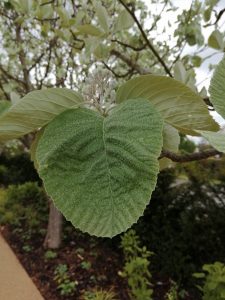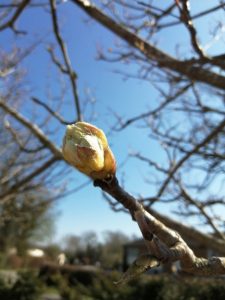The silent solace of trees
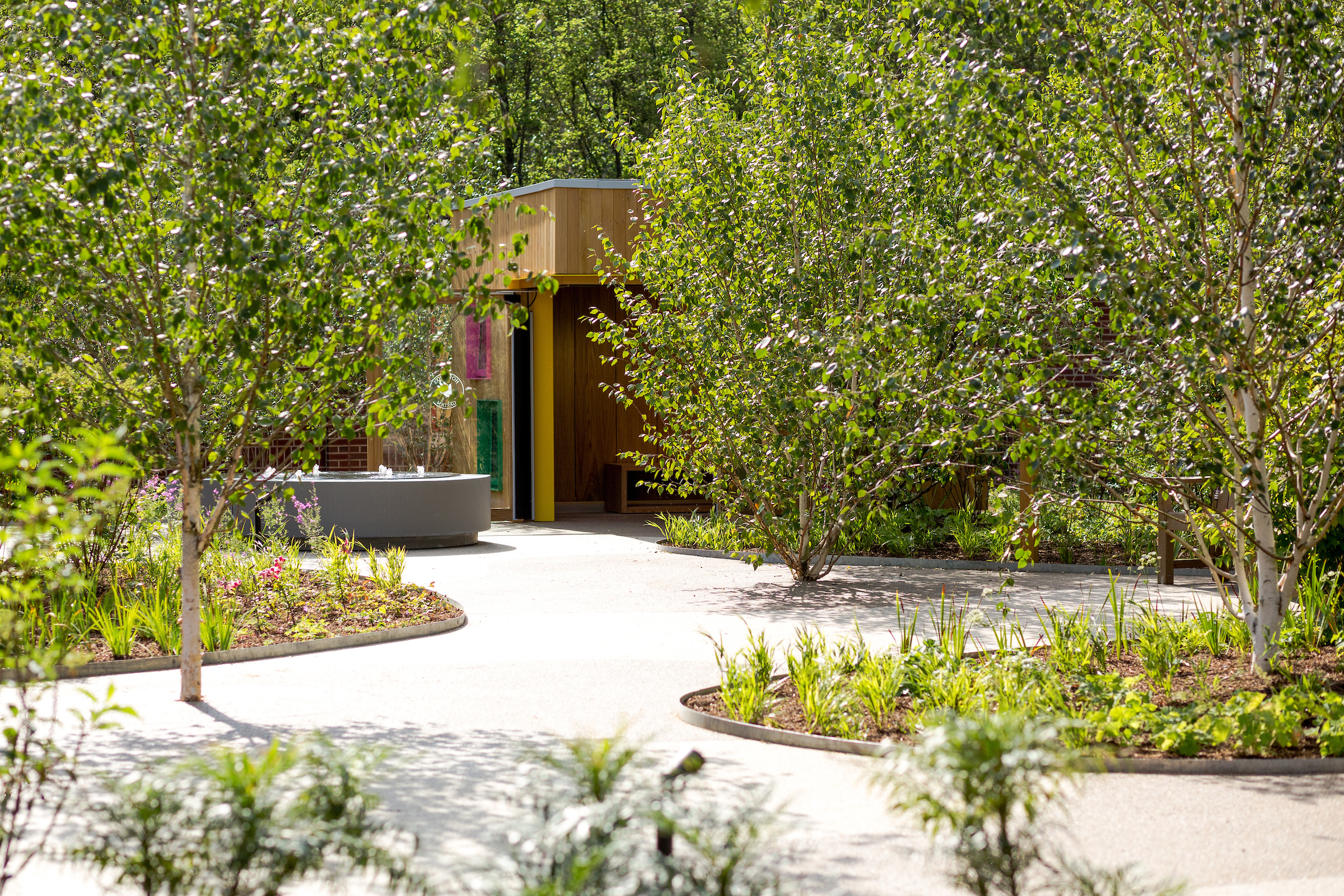
Above: Horatio’s Garden London & South East credit Lucy Shergold
Trees have been an integral part of garden design for thousands of years. They provide shade, colour, shape, fruit and blossom along with a wider sense of wellbeing. For Horatio’s Garden, a charity that creates and cares for beautiful, accessible gardens in NHS regional spinal injury centres and has been supported by the National Garden Scheme since 2015, trees are an important element of their gardens, helping to aid recovery and instil a sense of mindfulness and wonder as four of their head gardeners explain:
Imogen Jackson, Horatio’s Garden, Oswestry
I have more visitors to the garden asking about these trees than any other plant despite the fact they were planted long before Horatio’s Garden was created and many of these visitors will have walked past them hundreds of times previously and barely noticed them. The juxtaposition of these with the dark yew hedges, and underplanting of white Hydrangea ‘Annabelle’ seems to have really brought out their character.
The Sorbus aria is a native tree which has wonderful large, rounded leaves which are dark green and shiny on the top surface with a silver-white and downy underside. It looks amazing in stormy weather, its bi-coloured leaves flashing against darkening skies. In the spring they are covered in pretty clusters of white flowers, which attract many pollinators. In autumn, the leaves turn a rich russet and they bear orange-red fruit, chess apples, which apparently are edible once bletted. Not something I encourage patients to try, but the blackbirds adore them! This winter in amongst the leaf litter I have seen toads exploring; searching for a tasty feast and tucking into our burgeoning population of slugs.
- Sorbus Aria
- Sorbus in bud
These trees are planted opposite patient wards, where some patients spend months as they adjust to life after a spinal cord injury, often spending considerable time on bed rest. Many patients have told me how watching the trees has helped them immensely in their recovery journey. The abundance of wildlife that flits through them, the shifting colours and gentle movement in the wind gives them something external; something beautiful and ever changing to focus on. The contrast between this and the often stark, sterile ward environment for many patients is clear and has measurable healing effects. When patients are able to get outside the Sorbus offers shade or shelter.
Trees give huge solace to people who have faced trauma or grief. They act as silent, undemanding companions. They offer calm, peace and a sense of being held and comforted. They pass no judgement and demand no conversation. No-one needs to hide their true emotions, and this can allow for a gradual acceptance, a quietening of the mind, and through building a connection with nature enable a reconnection with self and others.
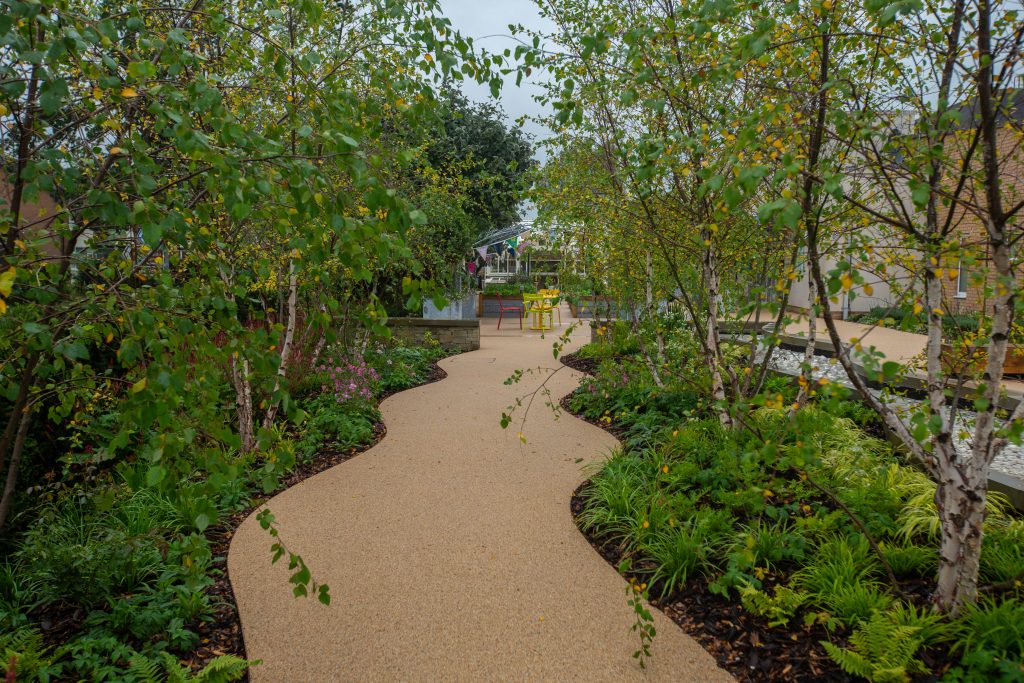
Stephen Hackett, Horatio’s Garden Salisbury
The Koelreuteria is a magical tree. It has a delightful, open form and gives pleasure all year round. Its leaves are pale green and delicate, turning to gold and russet in the autumn. During the summer it bears pretty spots of yellow flowers – hence one of its many names – the ‘Golden Rain Tree’ – which then ripen into seed pods like tiny Chinese lanterns. Truly a tree for all seasons.
Elsewhere in the garden we have nine varieties of apple, grown as espaliers along an archway. They are planted to ripen in succession, from the earliest ‘Discovery’ in late August to ‘Winter Gem’ in mid-October, though like all plants they don’t always follow the rules. Picking and eating a fresh apple is one of autumn’s great pleasures, and one which patients always enjoy.
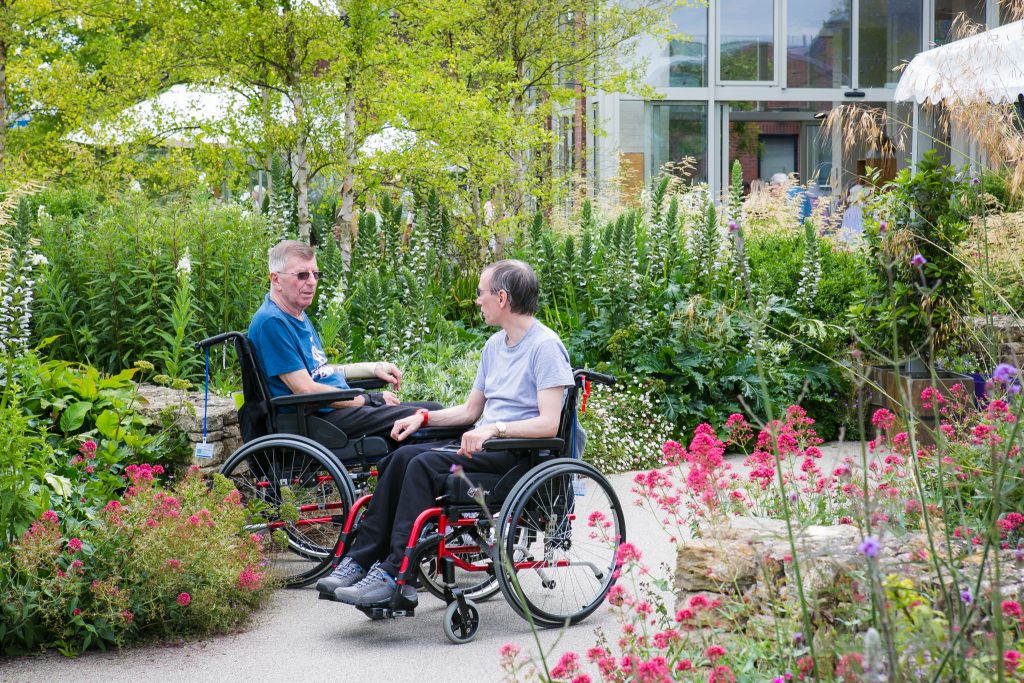
Patients enjoying the garden at Salisbury – credit Josh Humphrey
Jacqui Martin-Lof, Horatio’s Garden Stoke Mandeville
The trees at Horatio’s Garden Stoke Mandeville are the permanent backbone to the garden. Regardless of whether they are in leaf, in flower, in fruit or without leaf they give the garden a solid structure – a strength and a permanence.
Garden designer Joe Swift’s choice of trees offer all year-round interest; beginning with the much-welcomed early January pretty pink winter flowering cherry Prunus subhirtella autumnalis rosea, followed by the dark green foliage and mass of white spring blossoms of the ornamental pear Pyrus calleryana ‘Chanticleer’ with all round upright architectural interest with wonderful tactile red bark. The ancient Ginkgo biloba ‘Maidenhair tree’ stands proud with its light green fan-shaped leaves – turning to clear yellow in autumn. We also enjoy Malus domestica ‘Discovery’ with its showy spring blossom and delicious autumn fruit.
A wonderful selection that is very much admired by all users of the garden; patients, their visitors, staff as well as wildlife for all their endless seasonal qualities.
Ashley Edwards, Horatio’s Garden London: Stanmore
Albizia julibrissin also known as the ‘Persian silk tree’, is one of my favourite trees in the garden. It has beautiful divided foliage that casts a dappled shade. The leaves gently fold closed in the evening or in cool damp weather. In the summer and sporadically during warm spells, it produces gorgeous pink pompom blooms made up of thread like stamens. The inflorescence are easy for pollinators to reach making it an attractive tree for insects. Patients are able to enjoy the hum of bees and the dappled shade whilst sitting underneath.
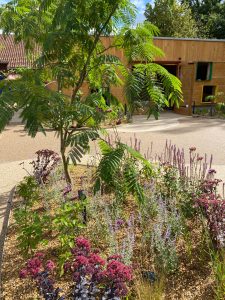
The Himalayan silver birch – Betula utilis var. Jacquemontii – planted in the garden give wonderful winter interest with their bright white trunks. They are planted in the pathways allowing patients to be right underneath them and feel their papery bark. They are pollen rich and provide habitat for birds who also eat the seeds.
Trees are so important for patients as they can provide shade and shelter as well as height which adds to the aesthetic beauty of the garden. Being under a tree, listening to the leaves rustle and watching the birds amongst the branches can be a moment of bliss. I enjoy the sense of maturity trees can provide to a garden as well as interest throughout the seasons. They can also act as shelter against wind and create a microclimate for growing a vast range of plants.
Many of Horatio’s Gardens open for the National Garden Scheme use our ‘Find A Garden’ page to discover more
For more on our support of Horatio’s Garden click here





